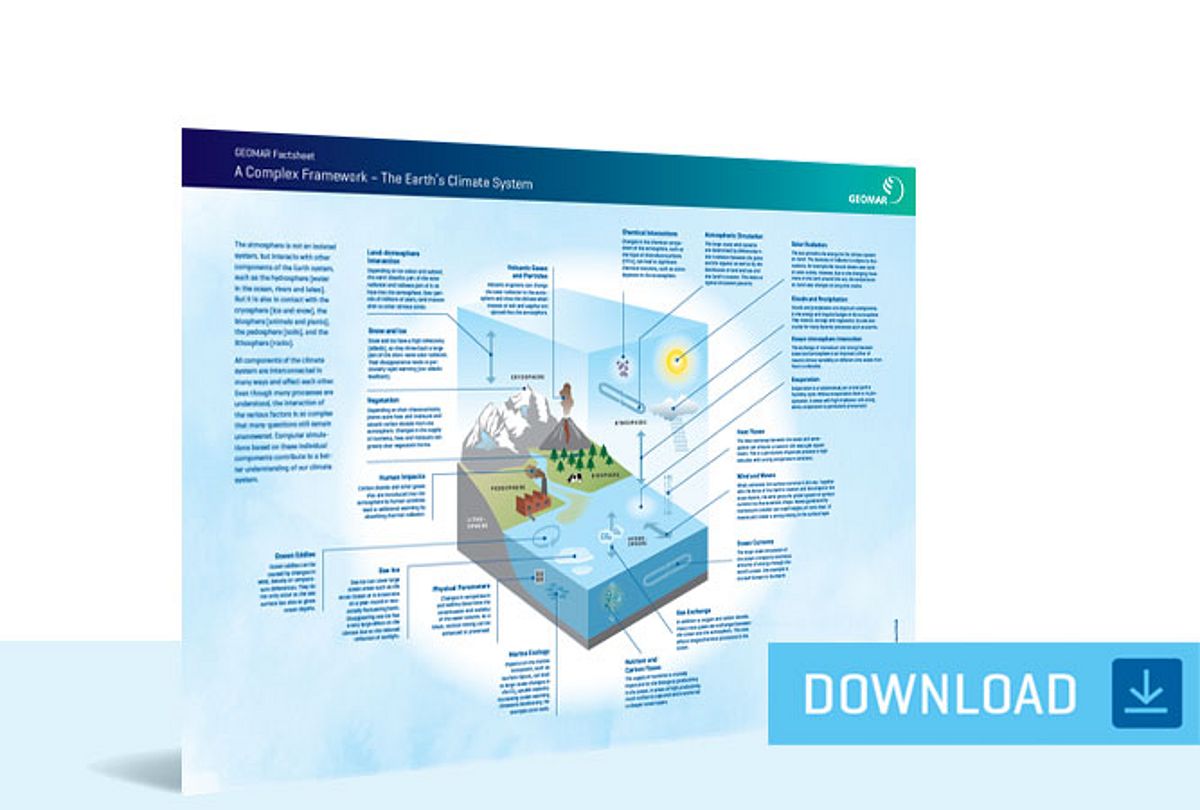GEOMAR Discover Ocean and Climate Model Simulations The Earth's Climate System
The atmosphere is not an isolated system, but interacts with other components of the Earth system, such as the hydrosphere (water in the ocean, rivers and lakes). But it is also in contact with the cryosphere (ice and snow), the biosphere (animals and plants), the pedosphere (soils), and the lithosphere (rocks). Click on the arrows on the right and left of the image to access the individual components.
01. HUMAN IMPACTS | Carbon dioxide and other gases that are introduced into the atmosphere by human activities lead to additional warming by absorbing thermal radiation.
02. VEGETATION | Depending on their characteristics, plants store heat and moisture and absorb carbon dioxide from the atmosphere. Changes in the supply of nutrients, heat and moisture can greatly alter vegetation forms.
03. SNOW AND ICE | Snow and ice have a high reflectivity (albedo), so they throw back a large part of the short-wave solar radiation. Their disappearance leads to particularly rapid warming (ice-albedo feedback).
04: LAND-ATMOSPHERE INTERACTION | Depending on its colour and subsoil, the earth absorbs part of the solar radiation and radiates part of it as heat into the atmosphere. Over periods of millions of years, land masses shift to other climate zones.
05. VOLCANIC GASES AND PARTICLES | Volcanic eruptions can change the solar radiation in the atmosphere and thus the climate when masses of ash and sulphur are ejected into the atmosphere.
06. CHEMICAL INTERACTIONS | Changes in the chemical composition of the atmosphere, such as the input of chlorofluorocarbons (CFCs), can lead to significant chemical reactions, such as ozone depletion in the stratosphere.
07. ATMOSPHERIC CIRCULATION | The large-scale wind systems are determined by differences in the irradiation between the poles and the equator as well as by the distribution of land and sea and the Earth's rotation. This leads to typical circulation patterns.
08. SOLAR RADIATION | The sun provides the energy for the climate system on Earth. The intensity of radiation is subject to fluctuations, for example the natural eleven-year cycle of solar activity. However, due to the changing movement of the Earth around the sun, the temperature on Earth also changes on long time scales.
09. CLOUDS AND PRECIPITATION | Clouds and precipitation are important components in the energy and impulse budget of the atmosphere. They interact strongly with vegetation, but are also crucial for many dynamic processes such as storms.
10. OCEAN-ATMOSPHERE INTERACTION | The exchange of momentum and energy between ocean and atmosphere is an important driver of natural climate variability on different time scales from hours to decades.
11. EVAPORATION | Evaporation is a fundamental part of the Earth's humidity cycle. Without evaporation there is no precipitation. In areas with high irradiation and strong winds, evaporation is particularly pronounced.
12. HEAT FLUXES | The heat exchange between the ocean and atmosphere can amount to several 100 watts per square metre. This is a particularly important process in high latitudes with strong temperature contrasts.
13. WIND AND WAVES | Winds stimulate the surface currents in the sea. Together with the force of the Earth's rotation and the shape of the ocean basins, the wind gives the global system of surface currents its characteristic shape. Waves generated by momentum transfer can reach heights of more than 10 metres and create a strong mixing of the surface layer.
14. OCEAN CURRENTS | The large-scale circulation of the ocean transports enormous amounts of energy through the world's ocean. One example is the Gulf Stream in the North Atlantic.
15. GAS EXCHANGE | In addition to oxygen and carbon dioxide, many trace gases are exchanged between the ocean and the atmosphere. This also affects biogeochemical processes in the ocean.
16. NUTRIENT AND CARBON FLUXES | The supply of nutrients is crucially important for the biological productivity in the ocean. In areas of high productivity, much carbon is captured and transferred to deeper ocean layers.
17. MARINE ECOLOGY | Impacts on the marine ecosystem, such as nutrient inputs, can lead to large-scale changes in the CO2 uptake capacity. Increasing ocean warming threatens biodiversity, for example coral reefs.
18. SEA ICE | Sea ice can cover large ocean areas such as the Arctic Ocean or in Antarctica on a year-round or seasonally fluctuating basis. Disappearing sea ice has a very large effect on the climate due to the reduced reflection of sunlight.
19. PHYSICAL PARAMETERS | Changes in temperature and salinity determine the stratification and stability of the water column. As a result, vertical mixing can be enhanced or prevented.
A Complex Framework: The Earth's Climate System
All components of the climate system are interconnected in many ways and affect each other. Even though many processes are understood, the interaction of the various factors is so complex that many questions still remain unanswered. Computer simulations based on these individual components contribute to a better understanding of our climate system.
More information on this topic in the World Ocean Review 1:
The Earth’s climate system – a complex framework
























